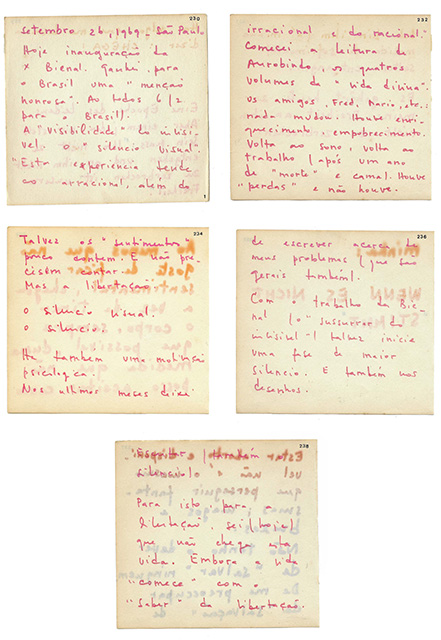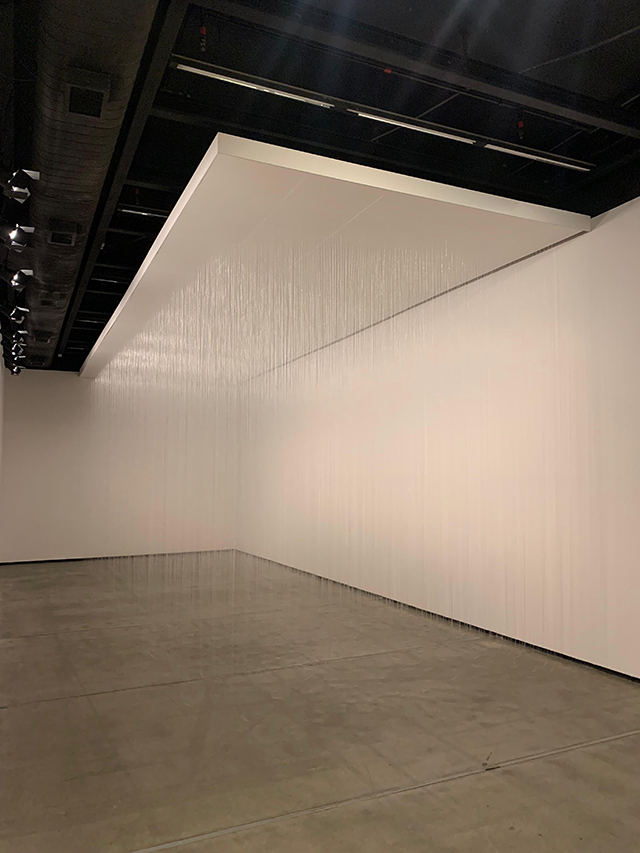Ondas paradas de probabilidade, um sussurro
Still waves of probability, a whisper
A instalação Ondas Paradas de Probabilidade foi realizada pela primeira vez na X Bienal de São Paulo (1969), que sofreu boicote explícito ou velado de diversos artistas brasileiros e estrangeiros em repúdio à suspensão dos direitos democráticos no país. Mira, assim como outros artistas em diálogo estreito com o crítico Mário Schenberg, decidiu participar da Bienal. Realizou ali sua obra de maior dimensão: um amplo campo com milhares de linhas de nylon translúcidas tensionadas apenas pelo seu próprio peso. Atravessadas pela luz, essas linhas se deixam perceber em uma visibilidade simultaneamente sutil e mesmerizante. Assim, no momento em que diversos artistas escolheram a retirada como ruidosa forma de silêncio, Mira construiu uma inefável forma de presença. Seus fios concretizam no espaço o vazio, a espessura, o silêncio e a distância como experiência sensível e compartilhável. Em paralelo, o texto bíblico que acompanha a obra aponta para a complementaridade entre presença e imanência como aspectos da existência. É neste mundo, agora, tal como ele é – na codependência sempre limítrofe entre imanência e presença, entre transparência e opacidade, entre penetrabilidade e embate –, que a espessura do sussurro e a densidade do corpo da palavra habitam.
The installation Ondas Paradas de Probabilidade [Still waves of probability] was first presented at the 10th São Paulo Biennial (1969), which faced an explicit or veiled boycott from several Brazilian and foreign artists in protest against the suspension of democratic rights in the country. Mira, along with other artists in close dialogue with the critic Mário Schenberg, decided to participate in the Biennial. There, she created her largest work: a vast field with thousands of translucent nylon threads, stretched only by their own weight. Traversed by light, these threads reveal themselves in a visibility that is at once subtle and mesmerizing. Thus, at a moment when many artists chose withdrawal as a loud form of silence, Mira constructed an ineffable form of presence. Her threads materialize void, thickness, silence, and distance as tangible, shared experiences in space. In parallel, the biblical text that accompanies the work points to the complementarity between presence and immanence as aspects of existence. It is in this world, now, as it is – in the ever-boundary-pushing interdependence between immanence and presence, transparency and opacity, penetrability and resistance – that the thickness of a whisper and the density of the word’s body reside.
Mira Schendel, Diário vermelho sobre viagem pelo Polo Norte [excerto]
Mira Schendel, Diário vermelho sobre viagem pelo Polo Norte [Red diary on a journey through the North Pole] [excerpt]
 Mira Schendel, Diário vermelho sobre viagem pelo Polo Norte [excerto] / Mira Schendel, Diário vermelho sobre viagem pelo Polo Norte [Red diary on a journey through the North Pole] [excerpt]
Mira Schendel, Diário vermelho sobre viagem pelo Polo Norte [excerto] / Mira Schendel, Diário vermelho sobre viagem pelo Polo Norte [Red diary on a journey through the North Pole] [excerpt]
Hoje inauguração da X Bienal. Ganhei para o Brasil uma “menção honrosa”. Ao todos 6 (2 para o Brasil).
A “visibilidade” do invisível. O “silêncio visual”. “Esta experiência tende ao irracional, além do irracional e do racional”. Comecei a leitura de Aurobindo, os quatros volumes da “vida divina”. Os amigos, Fred, Mario, etc.: nada mudou. Houve enriquecimento, empobrecimento. Volta ao sono, volta ao trabalho (após um ano de “morte” e cama). Houve “perdas” e não houve.
Talvez os “sentimentos” pouco contem. E não precisem contar.
Mas a libertação.
O silêncio visual.
O silêncio.
Há também uma motivação psicológica.
Nos últimos meses deixei de escrever acerca de meus problemas (que são gerais também).
Com o trabalho da Bienal (o “sussurrar do invisível”) talvez inicie uma fase de maior silêncio. E também nos desenhos.
Escutar (também o silêncio).
Para isto, para a libertação, sei (hoje) que não chega esta vida. Embora a vida “comece” com o “saber” da libertação.
 Mira Schendel, Diário vermelho sobre viagem pelo Polo Norte [excerto] / Mira Schendel, Diário vermelho sobre viagem pelo Polo Norte [Red diary on a journey through the North Pole] [excerpt]
Mira Schendel, Diário vermelho sobre viagem pelo Polo Norte [excerto] / Mira Schendel, Diário vermelho sobre viagem pelo Polo Norte [Red diary on a journey through the North Pole] [excerpt]
Today marks the inauguration of the X Biennial. I received an “honorable mention” for Brazil. In total, there are 6 (2 for Brazil).
The “visibility” of the invisible. The “visual silence.” “This experience tends toward the irrational, beyond the irrational and the rational.” I started reading Aurobindo, the four volumes of “The Life Divine.” Friends, Fred, Mario, etc.: nothing has changed. There has been enrichment, impoverishment. A return to sleep, a return to work (after a year of “death” and bed). There were “losses” and there were not.
Perhaps the “feelings” matter little. And perhaps they do not need to matter.
But the liberation.
The visual silence.
The silence.
There is also a psychological motivation.
In recent months, I stopped writing about my problems (which are also general).
With the work of the Biennial (the “whispering of the invisible”), I may begin a phase of greater silence. And also in the drawings.
Listening (also to the silence).
For this, for liberation, I know (today) that this life is not enough. Although life “begins” with the “knowing” of liberation.
